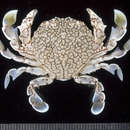en
names in breadcrumbs


Matutidae is a family of crabs, sometimes called moon crabs,[2] adapted for swimming or digging. They differ from the swimming crabs of the family Portunidae in that all five pairs of legs are flattened, rather than just the last pair, as in Portunidae. Crabs in the Matutidae are aggressive predators.[3]
Traditionally, this taxon contained the single genus Matuta, and was considered a subfamily of the Calappidae.[3] Now, the group is ranked as a family and six genera (four extant and two fossil) are now recognised.[4] Although placed in the Calappoidea, it is not clear that Matutidae and Calappidae are closely related.[5]
Szaboa is known only from Hungarian fossil deposits of Middle Miocene age.[6] Eomatuta was described from the Middle Eocene of Italy in 2009.[7] Fossils of Ashtoret have also been found in Miocene deposits in Japan.[6]
Matutidae is a family of crabs, sometimes called moon crabs, adapted for swimming or digging. They differ from the swimming crabs of the family Portunidae in that all five pairs of legs are flattened, rather than just the last pair, as in Portunidae. Crabs in the Matutidae are aggressive predators.
Les Matutidae sont une famille de crabes. Elle comprend quinze espèces actuelles et trois fossiles dans six genres dont deux fossiles.
Selon World Register of Marine Species (10 mars 2017)[1] :
Les Matutidae sont une famille de crabes. Elle comprend quinze espèces actuelles et trois fossiles dans six genres dont deux fossiles.
Ketam bulan (Rumphius: cattam bulan[3]), ketam bulan terang atau kepiting bulan, adalah segolongan kepiting anggota suku Matutidae. Ketam atau kepiting berukuran kecil dengan warna-warni cerah ini merupakan kepiting perenang, namun acap kali tinggal membenamkan diri di pasir dasar laut tepi pantai. Dalam bahasa asing ia dikenal sebagai Maans Krabbe (Bld.)[3] atau moon crabs (Ingg.).[4]
Rumphius menyebutnya ketam bulan atau ketam bulan terang (Amb.: yu hulam rita, yulan rita) karena ketam itu biasa ditangkap orang di pantai-pantai Amboina tatkala bulan purnama. Diceritakannya, ketika itu orang mencarinya dengan merangkak-rangkak di batas ombak dengan bersuluhkan damar.[3]
Meskipun demikian, ada pula yang (belakangan) mengasosiasikan nama tersebut dengan bentuk tempurungnya yang cenderung bundar serta warnanya yang pucat kekuningan.[4][5]
Ketam bulan mudah dikenal dengan memperhatikan bentuk karapasnya yang hampir bundar, sering dengan duri samping yang cukup panjang dan tajam. Sapitnya kokoh kekar, dengan banyak tonjolan serupa bisul, satu atau beberapa di antaranya berupa duri; tonjolan-tonjolan mana sering tersusun berderet, atau bahkan membentuk gigir atau lunas. Empat pasang kaki yang lain dengan ruas-ruas dactylus (ruas ujung) berbentuk serupa dayung atau daun meruncing; sangat efektif digunakan untuk berenang atau menggali pasir dengan cepat. Maksiliped (alat mulut) ke-III memanjang, ujungnya menyempit lancip, berpasangan rapat menutup lubang mulut jika tengah dilipat. Wilayah dahinya sempit, dengan antena (sungut) tidak berkembang atau rudimenter.[6]
Ketam bulan merupakan predator yang agresif,[6] memangsa aneka hewan laut kecil terutama krustasea dan moluska.[7] Tercatat beberapa mangsanya seperti kerang, cacing, serta bangkai ikan;[4][5] dan bahkan juga kepiting yang lain yang lebih kecil.[8]
Merupakan kepiting perenang dan penggali, yang tinggal membenamkan diri di substrat dasar laut yang lunak.[9] Biasanya ketam bulan didapati di dasar laut yang berpasir.[5]
Kebanyakan jenisnya hanya memiliki nilai komersial yang kecil, sebagai krustasea pangan yang kadang-kadang saja dijumpai di pasar.[9] Di antaranya di Maluku (setidaknya di masa lalu)[3] dan di Pakistan,[10] jenis-jenis ketam bulan biasa ditangkap orang untuk dimakan, dan adakalanya diperdagangkan.
Sebelumnya, ketam bulan hanya memiliki satu marga, yakni Matuta, yang tergolong ke dalam anak suku Matutinae, suku Calappidae.[6] Revisi oleh Galil & Clark (1994) memerinci kelompok ini menjadi 4 genera dan 14 spesies,[11] dan mendorong peningkatan statusnya menjadi suku tersendiri, Matutidae.[12] Belakangan, anggota suku ini bertambah dengan ditemukannya dua genera yang telah menjadi fosil.[13] Meski bersama-sama ditempatkan dalam super-suku Calappoidea, sebetulnya masih belum jelas lagi kedekatan hubungan perkerabatan antara Matutidae dan Calappidae.[14]
Daftar marga:[14]
|date= (bantuan) Ketam bulan (Rumphius: cattam bulan), ketam bulan terang atau kepiting bulan, adalah segolongan kepiting anggota suku Matutidae. Ketam atau kepiting berukuran kecil dengan warna-warni cerah ini merupakan kepiting perenang, namun acap kali tinggal membenamkan diri di pasir dasar laut tepi pantai. Dalam bahasa asing ia dikenal sebagai Maans Krabbe (Bld.) atau moon crabs (Ingg.).
Matutidae is een familie van de superfamilie Calappoidea uit de infraorde krabben en omvat de volgende geslachten: [2]
Matutidae is een familie van de superfamilie Calappoidea uit de infraorde krabben en omvat de volgende geslachten:
黎明蟹科(學名:Matutidae)是短尾下目(螃蟹)饅頭蟹總科的一個科[2],當地人稱之為「moon crabs」[3]。 與游泳的物種「梭子蟹科」不同的是:梭子蟹科只有最後一對足扁平化成泳肢,但黎明蟹科物種卻是全部五對足皆特化成為泳肢[4],以輔助游泳或挖掘。本科物種均為富侵略性的獵食者[5]。
傳統來說,本科過往只有黎明蟹屬(Matuta)一個屬,獨自成為饅頭蟹科的一個亞科[5]。現時,本分類被升格為科,包括有六個屬,當中有四個現存屬和兩個化石屬[2]。儘管本分類依然留在升格成為總科的饅頭蟹總科之內,現時我們仍未了解到底黎明蟹科及新的饅頭蟹科兩個分類的物種之間是否有緊密的關係[6]。
以下詳列本科的六個屬[2]:
Szaboa是現時已知唯一來自匈牙利中新世中期化石沉積層的物種[8],Eomatuta同樣來自中新世中期的地層,於2009年在意大利發現[9]。月神蟹屬的化石亦有在日本的中新世地層發現[8],但月神蟹屬仍然有現存物種。